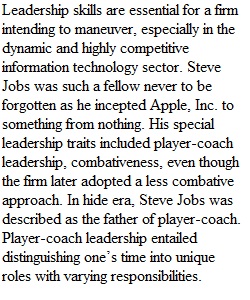


Q STAND-ALONE PROJECT MB661 Leadership and Motivation Stand-Alone Project: CEO Analysis (200 points) You should begin working on the Stand-Alone Project early in the course. Each lesson provides a benchmark for completing the Stand-Alone Project in a timely manner while working through the course. You will find this information in the “Stand-Alone Project Benchmark” section of each lesson. (200 points) (A 10-page response is required for the combination of Parts A, B, and C.) Instructions: For the Stand Alone Project, you will use the concepts you have learned to analyze a CEO's leadership abilities. Select a current or former CEO of your choosing. The CEO you choose does not necessarily have to be a successful or popular CEO. The person you choose may be, or have been, very unsuccessful or unpopular. However, you should find him or her to be interesting and a good example of many of the concepts you have studied in this course. You will want to choose someone fairly well known or, more specifically, someone well documented in order to have ample material for your analysis. You are required to review a minimum of (6) sources of information about the CEO in order to form your own conclusions and to obtain significant data relating to all the required concepts. Part A Introduction: Provide a 1-2 paragraph synopsis of your entire paper, similar to the abstract of a journal article. In the introduction, you should summarize the topic and your conclusions. Part B Career Overview: This portion of your paper should provide a comprehensive overview of the CEO's career, highlights, achievements, and significant events. You must have a minimum of six (6) sources. These sources may be newspaper or magazine articles, books, or corporate press releases. The Ashworth College Proquest library also may provide articles for your review. In your search, do not focus simply on articles about the CEO. You should also attempt to find articles and/or books about the organization during the time the CEO was in charge. In addition, you should search for any written works by the CEO, which may provide excellent insight into him or her. Review as many sources as necessary to develop an in-depth understanding of the leader and his or her style of leadership. ? Part C Conclusions and Examples: In this section, draw conclusions regarding the CEO's leadership, focusing on the topics covered in the text. In addition to drawing conclusions, you must support your evaluation with specific behavioral examples drawn from your research. For example, if you were to state that Mr. Smith was clearly a highly extroverted individual; you would need to provide some evidence for that conclusion. You might state, “It is clear that Mr. Smith was highly extroverted based on numerous examples of his desire to be in the limelight. At an early age, Mr. Smith joined drama and debate teams and ran for class offices. Once he joined the corporate arena, Mr. Smith's colleagues consistently described him as ‘the life of the party.’” You must address the following concepts, or topics, in your Conclusions section. 1. Personality and Leadership Style 2. Courage and Moral Leadership 3. Culture and Values 4. Communication 5. Motivation and Empowerment 6. Power and Influence 7. Vision and Strategic Direction Please keep in mind that the objective of this section is to demonstrate a thorough understanding of the required concepts, or topics. These topics are fairly broad and require a significant amount of discussion to demonstrate full knowledge. As a rule of thumb, you should cover no fewer than two (2) subtopics to sufficiently cover any given topic. For example, to discuss personality and leadership style fully, I might choose to discuss the Big-Five model: locus of control, authoritarianism, Theory X and Y, and charisma. I would choose these concepts both because they give a good overview of the topic I am required to cover and because the information I have gathered on the CEO I have chosen includes several examples I can use to illustrate these concepts. As I mentioned above, the CEO you choose does not necessarily need to demonstrate superior performance or glowing examples of the concepts. You may cite examples that demonstrate a lack of charisma. Grading Rubric Please refer to the rubric on the following pages for the grading criteria for this assignment.
View Related Questions